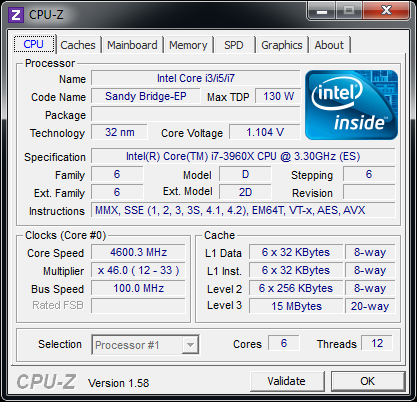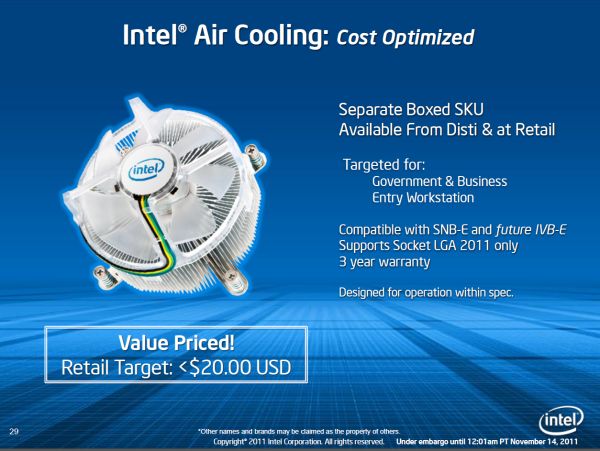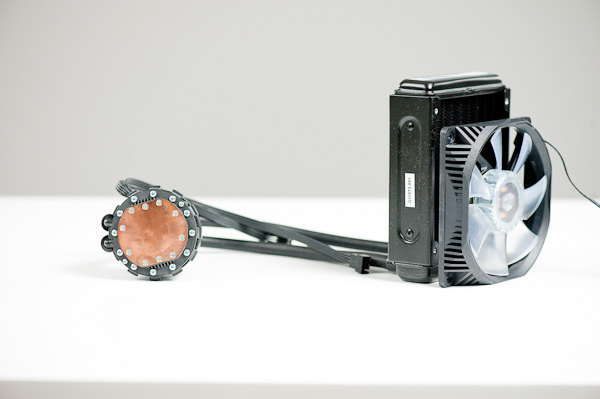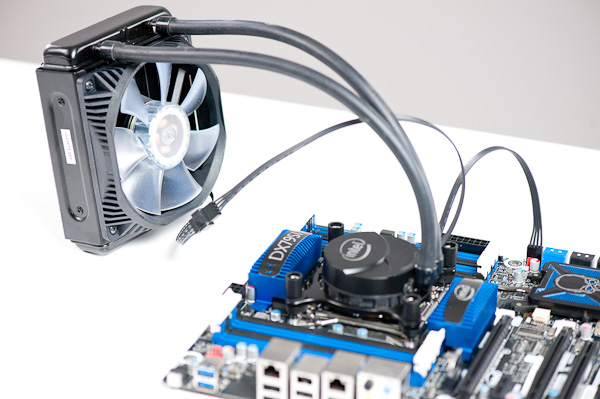Intel Core i7 3960X (Sandy Bridge E) Review: Keeping the High End Alive
by Anand Lal Shimpi on November 14, 2011 3:01 AM EST- Posted in
- CPUs
- Intel
- Core i7
- Sandy Bridge
- Sandy Bridge E
Overclocking
Sandy Bridge brought the motherboard's clock generator onto the 6-series chipset die. In doing so, Intel also locked its operation to 100MHz. While there was a bit of wiggle room, when combined with a locked processor, Intel effectively killed overclocking with most lower end Sandy Bridge chips.
For its more expensive CPUs, Intel offered either partially or fully unlocked (K-series) CPUs. The bus clock was still fixed at 100MHz, but you could overclock your processor by increasing its clock multiplier just like you could in the early days of overclocking.
With Sandy Bridge E, overclocking changes a bit. The clock generator is still mostly impervious to significant bus clock changes, however you're now able to send a multiple of its frequency to the CPU if you so desire. The options available are 100MHz, 125MHz, 166MHz and 250MHz.
Once again, wiggle room at any of these frequencies is limited so don't think we've moved back to the days of bus overclocking. You do get a little more flexibility, particularly with partially unlocked CPUs, but otherwise SNB-E overclocking is hardly any different from its predecessor.
Note that even if you select any of these options, the rest of the system still operates within spec. The multiplied bus clock is only fed to the CPU.

With a bit of effort I had no problems hitting 4.6GHz on my Core i7 3960X review sample. I had to increase core voltage from 1.104V to 1.44V, but the system was stable. While I could get into Windows at 4.8GHz and run a few benchmarks, the system wasn't completely stable.
No Cooler Included
None of the retail or OEM SNB-E parts include an Intel cooler in the bundle, a significant departure from previous CPUs. Presumably the cost of bundling a beefy cooler with these parts would've driven prices higher than Intel would've liked (remember you are getting a much larger die for roughly the same price as the outgoing Core i7 990X). Intel can also rationalize its decision against including any sort of cooler in the retail box by looking at the fact that many enthusiasts at this level opt for aftermarket cooling regardless.
Intel hasn't completely left SNB-E cooling up to 3rd party vendors however. There are two official Intel coolers available for use with SNB-E. The first is a < $20 heatsink that looks a lot like Intel's current coolers but with a couple of modifications (clear fan/shroud, retention screws instead of pegs). Intel states that this cooler is designed for operation within spec, meaning it could possibly limit overclocking attempts.

If you want an Intel branded overclocking solution, there's the RTS2011LC:

This is a closed loop liquid cooling solution similar to what AMD introduced alongside its Bulldozer CPU and similar to what many 3rd party cooling companies already offer. Intel expects its liquid cooling solution to be priced somewhere in the $85 - $100 range.
These closed loop liquid coolers are great primarily for getting away from the tower-of-metal heatsinks that have grown in popularity over the past several years. The radiator is a too small to compete with more traditional water cooling systems, but it can be a good gateway drug for the risk averse.











163 Comments
View All Comments
Zak - Monday, November 14, 2011 - link
I want native USB3 plus significantly higher number of PCIe channels so I can run two cards at full 16x and a decent RAID controller at 4x without having to pay over $300 for the mobo. Oh, and for god's sake say goodbye to the PCI slots please while improving the motherboard layout so dual slot cards don't cover any available PCIe slots.Bullshit like "Three PCIe x16 slots!!!! (running at 8x, 8x, 2x) make me sick. The latest Intel motherboards were rather underwhelming in terms of features.
chizow - Monday, November 14, 2011 - link
It really seems as if Intel wants to kill off this high-end enthusiast desktop segment completely; what we have here is a by-product of their server market and perhaps the last of a dying breed. First sign was the change to multiple sockets and locking clock frequency on their non-enthusiast parts. Also, SB-E comes with a huge increase in platform cost compared to Nehalem that doesn't really justify the increase in performance over SB.$500 for the entry-level SB-E CPU and $300+ for the motherboard is going to be a bitter pill to swallow for those used to the $200-$300 entry-level Nehalem CPUs and $200 boards. I know there's going to be a 4-core part that may be closer to that price point sometime next year, but again, one has to ask if it will be worthwhile over a 2600K at that point, especially since the K is unlocked and the SB-E part isn't.
Also factor in the reality PCIE 3.0 is going to be a negligible benefit of the chipset. Maybe if ATI/Nvidia's next-gen GPUs make use of the extra bandwidth. You also don't get any additional benefits in the way of SATA or USB support compared to last-gen SB products....its really quite disappointing for a chipset that was held off this long.
Overall the performance looks good, but at the price and size....is this the path CPUs are headed for? Huge and hot like GPUs? I mean we thought Bulldozer was massive, SB-E is just as big but at least it delivers when it comes to performance I guess. I can see why Intel wanted to bifurcate their server/desktop business, but I think the unfortunate casualty will be the high-end enthusiast market that don't want to pay e"X"treme prices for the privelege.
redisnidma - Monday, November 14, 2011 - link
Looking at these results, you have to wander what in the world was AMD thinking when they designed Bulldozer (AKA Crapdozer).Feel sorry for them. :(
just4U - Monday, November 14, 2011 - link
For the most part Amd's bulldozer did give us 2500K speeds.. and multithreaded performance is there. This cpu is the fastest we've seen but it certainly doesn't blow one away in comparison to the 2600K. The Amd CPU is criticized for one thing really.. it's single threaded performance which is no better then it's cheapest proccessors.Guspaz - Monday, November 14, 2011 - link
A minor performance boost in most real-world scenarios, and yet a massive increase in cost and power consumption...This whole chip is basically a big kludge. Take an 8-core Xeon and disable a quarter of the chip, slap a "consumer" label on it, and call it a day? That's not even trying, that's just lazy.
This chip is 50% faster than SNB in heavily multithreaded applications because it has 50% more cores. A much more interesting chip would have been to take the existing SandyBridge chips and increase the core count, rather than taking a Xeon and disabling parts of the core.
EJ257 - Monday, November 14, 2011 - link
Actually isn't that basically what they did with this? They took 8 SB cores and threw it on the die, took out the IGP and dropped in a massive L3 cache. I mean if your going to be building a gaming rig based on SB-E, would you actually care about the IGP at that point when you got SLI or X-Fire GPUs?I understand how this move would make some people feel like they've been slapped in the face by Intel. Years as loyal customers and this time around they get a "crippled" part to call a flagship. Look at what the state of the high end CPU market is like. At this point Intel is dominating and there is really no incentive for them to do a completely different chip when a "crippled" Xeon can run circles around the best AMD has to offer. From their point of view this is the most economic way to do business. But yes, meh indeed when you already have a i7 2600K running smoothly.
adamantinepiggy - Monday, November 14, 2011 - link
Or will there be a desktop version again without ECC support and a workstation Xeon version that does? (890x/990x vs x5680 Xeon) I'll take ECC support for RAM over faster RAM with eight populated slots please. The larger and larger memory amounts means more likelihood of bit errors, but for two generations of CPU's from Intel, no EEC RAM support on the CPU memory controller.hechacker1 - Monday, November 14, 2011 - link
I agree. With massive amounts of memory that you could potentially put onto this platform, I'd really like to have a version with ECC for the workstation.BSMonitor - Monday, November 14, 2011 - link
I understand the need to keep news positive for AMD. Competition and all. However, repeatedly stating over time that they are competitive on price is kind of misleading in the grand scheme. Each new CPU arch. from Intel yields double digit performance gains(lately). AMD's are often delayed and in BD's case yield backwards results in many benchmarks.The truth is, clock for clock, given as many transistors, given as much power and heat, AMD is grossly not competitive.
The ONLY reason one can say that their chips are competitive in relation to price, is that they have NO other choice but to sell them at that price. AMD looks at where it's new CPU's relate in terms of performance to Intel's lineup and price accordingly. As many R&D $$, transistors, etc that go into each FX-8150, the flagship CPU should be at least competing with the 2600K, 990X, etc of the world. Forcing either Intel either to lower the $1000 tag on SNB-E or allowing AMD a $1000 alternative.
However, all we get from AMD is mediocre, late to market attempts to "catch-up". My point, AMD needs a new infusion of engineers and/or new approach. A complete new idea/redesign/etc..
Let's face it, the x86 market is now Intel x86. Perhaps, AMD should take what it knows in processor design and embrace a new idea.. Maybe a mixed ARM/x86 or an enhanced ARM 64-bit for desktop PCs. Something to stand out and deliver on. Pure x86, AMD is falling further behind. BD did not even catch up to 4 core SNB. And Ivy Bridge is being held back, as there is no really competition for it. The landscape looks like AMD will be out of the desktop CPU space within a year or two. Or at least religated to Cyrix status from the 2000's.
bji - Monday, November 14, 2011 - link
Your point about AMD's prices don't make any sense. You're saying that AMD is not a good value because it is selling its chips at a price that makes them a good value rather than making faster chips and selling them for more money like Intel does?!?Since when does "a good price:performance ratio" not equal "a good value" just because the CPU vendor doesn't have high (or any!) profit margins?